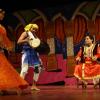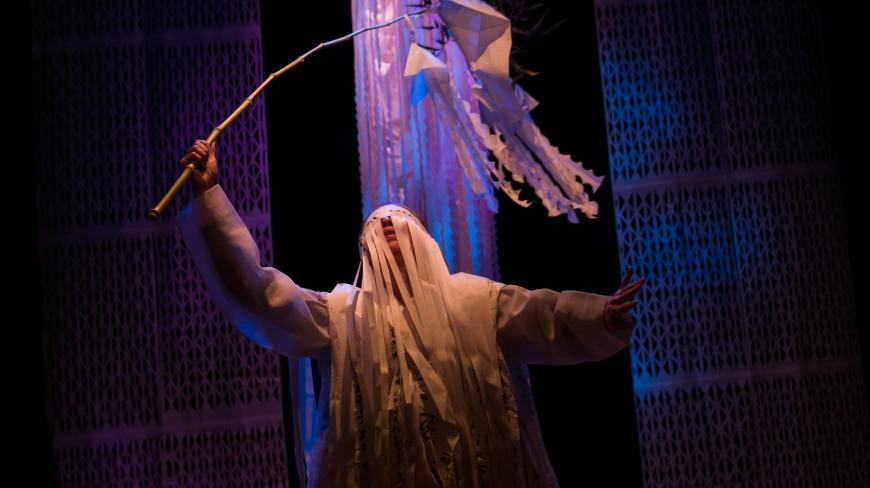
Yerba Buena Center for the Arts has a great variety of presentations, but next week, it will offer something altogether different from its usual performing arts events.
On June 23 and 24, Korean shamanistic performance artist and choreographer Dohee Lee will present MU–Connector/When the land stands alone, “a serialized ritual and theater experience.” (An MU connector is a small, compact variety of optical fiber connector.)
Lee says the event “explores ancestral traditions transmuted through dance, singing, drumming, and storytelling, weaving together electronic soundscapes, an altar installation, and community participation to create a communal creative ritual experience.”
Built from collective community healing rituals, MU–Connector delves into “our myths, ancestral land, history, and stories, while also reflecting on wounds suffered and inflicted through systemic oppression in the U.S. and our homelands.”
The show features Bhutanese performance collective The Storytellers, Nepali musician and composer Manose Singh, and CoRazOn/CRE Cohorts and is followed by a screening of a new film, I Hear a Butterfly, on June 25. The film is created by Asian Refugees United, and it features community members sharing their stories of migration and resilience.
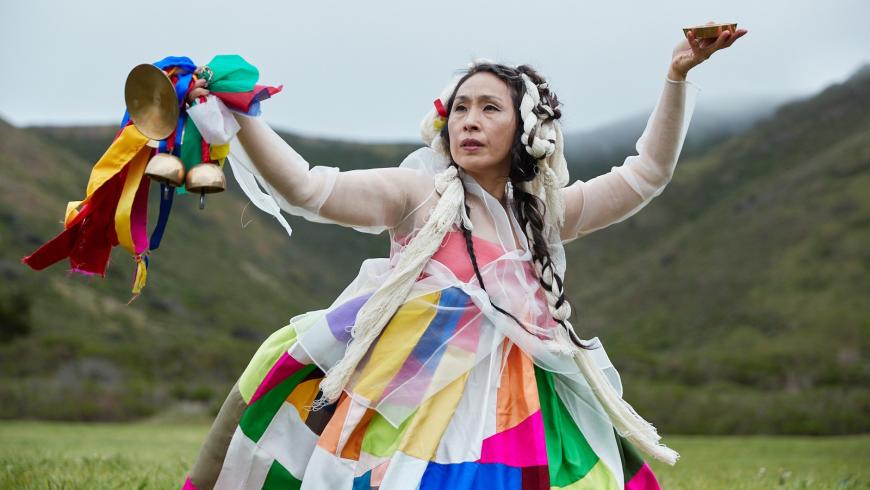
Born on Jeju Island, Korea, Lee trained in music and dance styles rooted in Korean shamanism. In 2002, she moved to Oakland, California, to create a new art form. Since then, she has become an award-winning performer, collaborating with Kronos Quartet, choreographer Anna Halprin, inkBoat, Degenerate Art Ensemble, and many others.
Lee’s work ranges from solo performances to full-scale theatrical productions. She utilizes wearable wireless controller technology to integrate acoustic and electronic sounds, video projections, dance, vocals, and rhythm. Throughout her work, she emphasizes the mythical, experimental, ritualistic, historical, and healing aspects of performance and installation, revealing new relationships between identity, nature, spirituality, and politics.
Shamanism is a system of religious practice that’s older than all other religions in Korea. Historically, it is often associated with Indigenous and tribal societies and involves the belief that shamans, with a connection to the otherworld, have the power to heal the sick, communicate with spirits, and escort the souls of the dead to the afterlife.
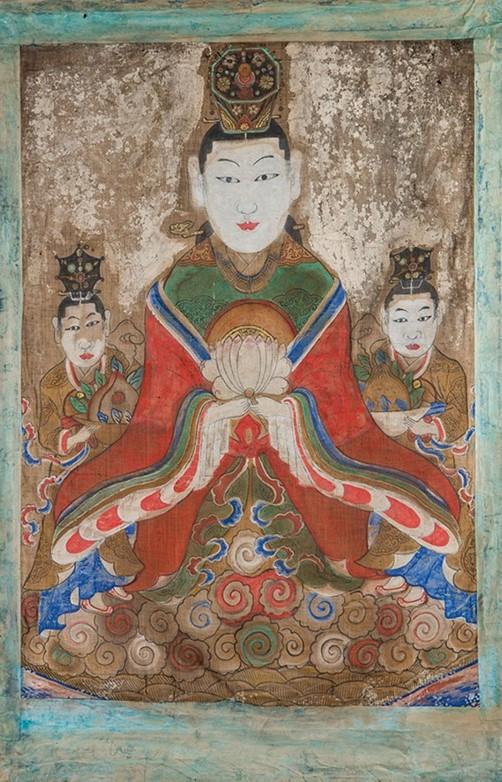
Korean shamanism is part of everyday life in the country and is often depicted in literature, film, and TV series. Jung Eun-gwol’s novel The Moon That Embraces the Sun, about the love affair between a Joseon-era king and a female shaman (with a plot echoing Jane Austen’s Persuasion, no less), has been adapted into a popular K-drama.
In Korea (and elsewhere), the shaman is a bridge between the spirit world and the earthly world. Spirits, often of deceased ancestors, can interact with people and cause them good fortune or pain and misfortune.
In Western culture, there are echoes of this bridge between different dimensions in the Faust and Orpheus legends, which have inspired a host of plays and operas. One contemporary example is Tom Stoppard’s The Invention of Love, which tells of the poet A.E. Housman standing on the bank of the river Styx, about to transit to the afterlife on the ferry captained by Charon.
Lee told SF Classical Voice about the Korean meaning of shamanism:
I trained in traditional Korean dance and music — [specifically] drumming — deeply rooted in Korean shamanism. And I came here [to the U.S.] in 2002 to continue to develop both traditional and contemporary art forms that are intended to heal.
That is the main reason that I founded Puri Arts [Lee’s producing organization] in 2004. Puri means releasing suppressed spirits. I had to do this for myself to heal and transform the life that I have to continue to live.
This is a life process that I am [continually] learning. … This cultural practice is deeply connected with the communal spirit, which motivates [a group of people] to build a community or village and create a support system for healing.
Knowing my culture, language, ritual practice, and tradition living in America is such an important responsibility [for me] as a Korean descendant.
I am here to respond to the spiritual calling of what we need to do — how we can decolonize our body, land, and spirituality so that we can deeply connect to the land, nature, and ancestors [and so] that all the beings in our village and humanity [can live] in a harmonious way on this planet.”
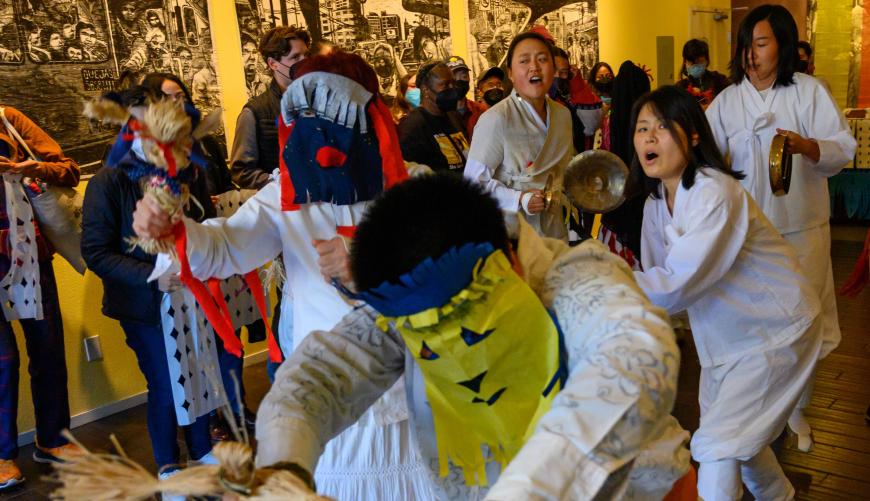
Has living in Oakland changed Lee’s relationship to shamanism?
“Living in America with this ritual-based work was not easy for me. Many Koreans in America belong to the very large Christian community. That says [a lot about the] religious colonization that this country has been built on. And other spiritual practices have been oppressed — some Indigenous communities say they went [into a] ‘deep sleep.’
“I have been [negotiating this balance] since I arrived here in so many different ways and never gave up on appreciating the roots of my culture — all the dance, music, and so many practices [that] are so deeply influenced by the Korean belief system. My practice in this country is the same as decolonizing spirituality, reawakening spirituality, and bringing back the matriarchal way of structuring this system.
“I believe in doing this practice as activism, spiritual activism that [the U.S.] has had so much of a relationship with, [going] back to our ancestral countries.
“This is not just about me doing the cultural performance. It is about speaking about forbidden, buried histories that were never told or went into sleep because of so much pain and fear. This time that we are living in is the time to allow them to speak up, to unbury their silenced voices, [the time for] awakening and healing.”



